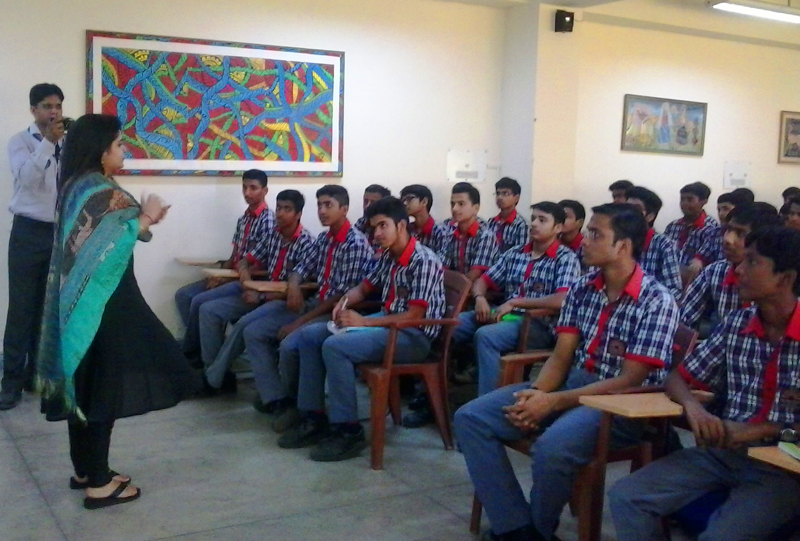Kendriya Vidyalaya, Pragati Vihar, New Delhi
Centre for Social Research (CSR) in participation with Nanakpura Police Station conducted a Gender Sensitization Training Session with the students of Kendriya Vidyalaya in Pragati Vihar, Delhi on 8th October, 2015. The training had over 150 students in attendance comprising of class Xth and XIth boys. The training was facilitated by Ms Ritika Bhatia, Ms Debarati Sarkar and Ms Smriti Sharma from CSR. The Delhi Police staff also accompanied them for the session.


The session began with an introductory note from the Principal whose concern for this training was with India having a large number of population belonging to the age group of 15-35. Subsequently, Ms Ritika explained that in order to seize the benefits of a young population there is a need for the contribution of both sexes to development. Thus, there lie a need for gender sensitive training in order to develop an understanding of existing gender relations. This was followed by putting the category of ‘Gender’ up for discussion. She asked them what they understood by the term. Amidst the giggle and laughter, there were two main responses. Firstly, a boy relates the term gender with caste. Secondly, a majority of them rightly understood it as the male-female binary. In continuum, the category of ‘sex’ of taken up. Some comprehended the term as male-female. While some associated it with physiological features, based on which we classify males and females. To illustrate the latter, an example of men having beard and women having long hair was given and students were asked what these examples implied. Did it imply gender or sex? It was Nikhil, a boy from class X who rightly said that these were nothing but instances of ‘sex’, which signifies the way nature has made us. The first part of the session ended with the Sex-Gender distinction, wherein ‘sex’ implies biological differences between men and women. While ‘gender’ is nothing but a social construct, the manner in which society perceives us.
The session continued with key emphasis on the category of ‘gender’, giving special focus to the ‘roles’ associated with the same. An activity was conducted amongst wherein the students were divided into two groups, A and B. Group A and B were told to contemplate like women and men respectively. Subsequently, list of the roles associated with each was written down on the board. Roles attached to women ranged from doing household work, shopping, gossiping, watching serials, putting make up to not staying outdoors for long. An interesting response from a boy was that while women were supposed to do household work, nonetheless it qualified as ‘hard work’. On the other hand, roles related to men were seen as playing outdoors, going to the gym, doing night-outs with friends, watching news and matches on TV, going to the office, etc. Once they had given their views on the same, they were asked to close their eyes. With restlessness beginning to settle, they were then asked to open their eyes. In that time frame, the roles listed for men and women respectively were switched. The purpose of doing this was to question the roles that they had associated with men and women; to enlighten them that such an affiliation was nothing but stereotypical and that we needed to reason them out. All work that men did, women too could do and vice-versa.
The discussion then transitioned to why they had mentioned the roles assigned for women and men specifically as they did. Therefore, the concept of ‘Gender Socialization’ was carried out on the floor for discussion. It was elucidated that this was an outcome of the process of socialization that happens at an early age. From the time a child is born, we begin the process of socialization with, for instance a color specification for each sex. ‘Blue’ for boys and ‘Pink’ for girls. Moreover, a list of don’ts precedes a list of do’s. Men are not supposed to be emotional or supposed to express pain, etc. Hence, with such stereotypical classification of ‘gender roles’ a need was stressed to assert ‘Gender Equality’, were both men and women are seen as equal. Simultaneously, she enlightened traditional beliefs, patriarchal systems, time constraints due to multiple roles, social and cultural restrictions, and limited involvement in decision-making processes exclude women from the public sphere, limiting their access to information and capacity building activities.
The session ended with asking the purpose of this session. The facilitators emphasized the need for this being to bring about an attitudinal change. A change, which they believed, would help them and several other boys or men in becoming better fathers and better life partners. In the interaction round, amongst several interesting questions, one that stood out and gained attention was that we had only spoken about inequalities with females.
What about the inequality that men have to face in terms of, for instance reservation of a coach for females and not males? In response, they were illustrated that they were negating a sense of safety and security that women need today and their long history of struggle. Finally, the session concluded with asking students to ponder upon today’s session, with the hope that they would learn and inculcate the same in their own lives.




